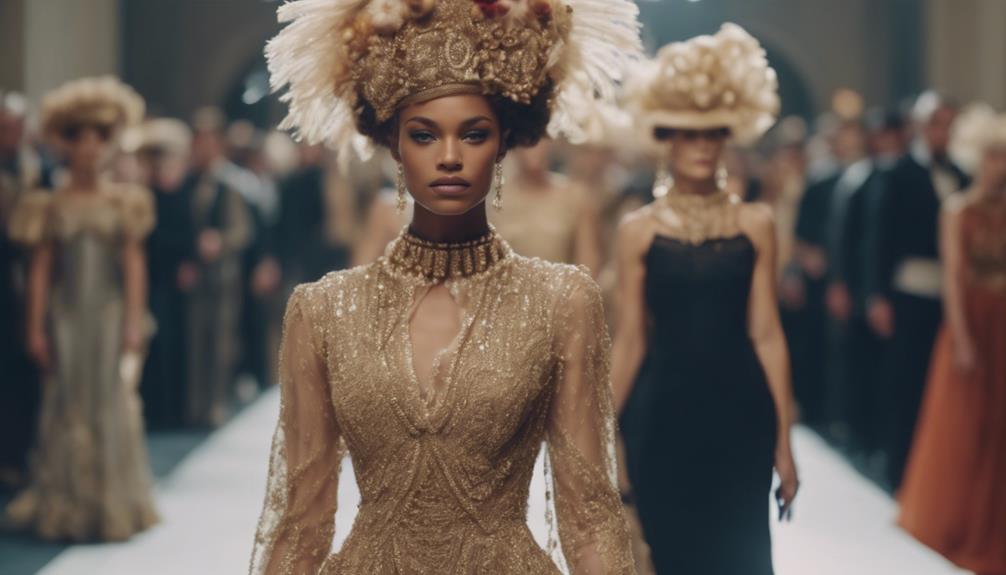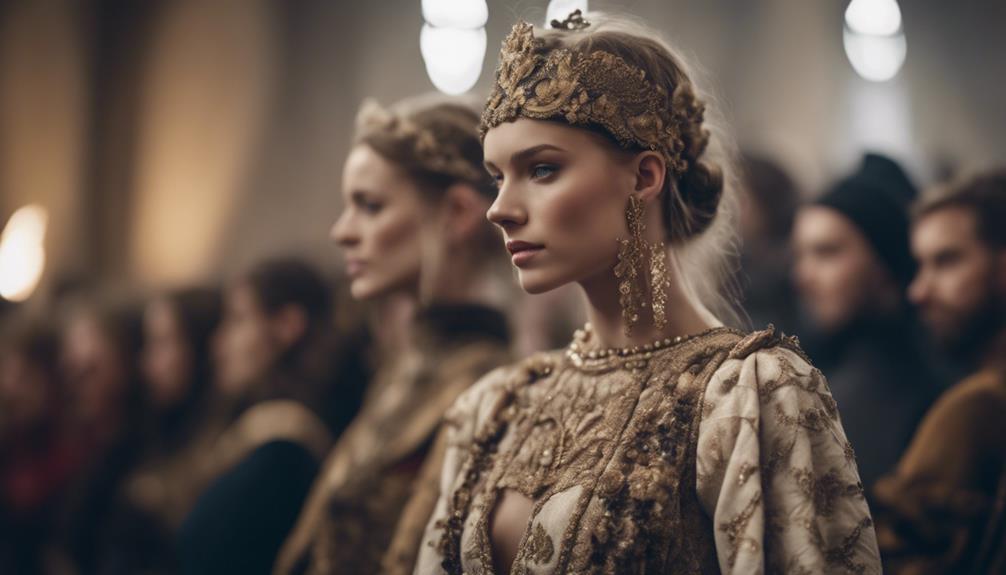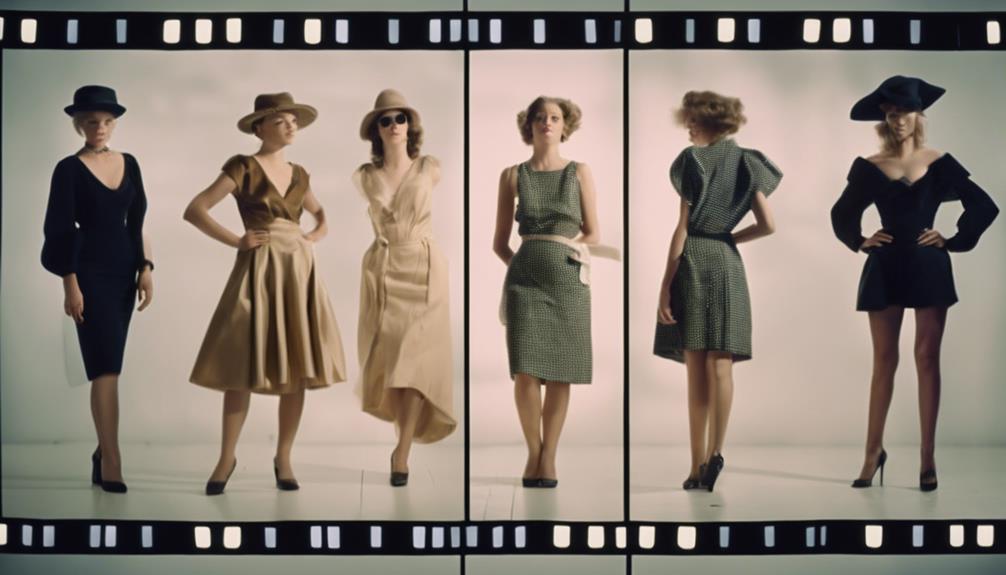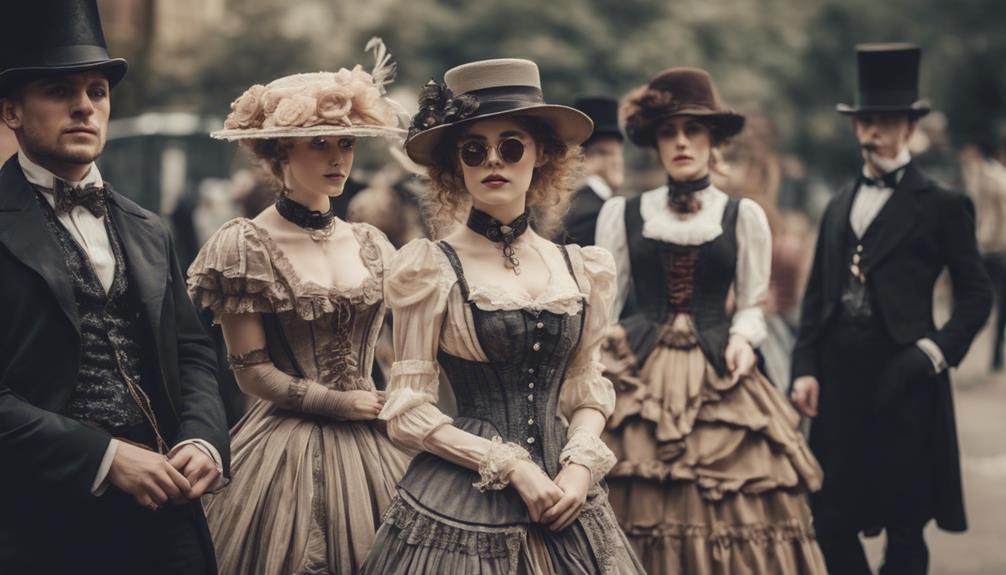You're on the brink of discovering a fashion trend so trendy and enigmatic that even the fashion police struggle to catch up with its allure! Its mystery and hotness are sending shockwaves through the fashion scene like never before. Unravel the secrets behind this sizzling style that has everyone talking and enthusiastic to emulate. Get ready to embrace this cutting-edge trend that is redefining the fashion landscape. Get ready to be captivated by its charm and impact. There's a world of fashion wonders waiting for you to explore!
Key Takeaways
- The mystery style is trending rapidly, challenging traditional fashion norms.
- Its popularity surpasses the capacity of fashion authorities to regulate or keep pace.
- This style's elusive nature and rapid evolution defy conventional fashion policing.
- Fashion police struggle to define or control this ever-changing and enigmatic trend.
- The allure and appeal of this mysterious style outpace the enforcement capabilities of fashion regulators.
Origins of Sumptuary Laws
Sumptuary laws trace back to ancient civilizations, where restrictions were imposed on extravagant displays of wealth and fashion. The concept of the Fashion Police, although not officially termed as such, can be seen in the enforcement of these laws.
In Sparta, for instance, elaborate homes and furniture were restricted to maintain a sense of equality among citizens. Similarly, ancient Rome focused on limiting excess adornment and extravagant clothing to prevent ostentatious displays of wealth.
As societies evolved, sumptuary legislation reached its peak during the late medieval period and Renaissance, with Italy leading in its implementation. Governments believed that regulating dress style through these laws could influence moral, economic, and social dynamics.
Dos and donts for dressing were explicitly dictated, with distinctions made between what was acceptable for men and women during medieval and Renaissance times. The origins of sumptuary laws reveal a historical attempt to control societal behaviors through regulating fashion choices.
Purpose Behind Sumptuary Legislation

The underlying motive for implementing strict regulations on fashion can be traced back to a desire to shape societal values and behaviors. Sumptuary laws aimed to curb extravagance and regulate the use of luxury items within society. Governments believed that controlling dress styles could have a significant impact on the moral, economic, and social fabric of a community.
Prominent countries like France, England, and Italy were known for enforcing stringent sumptuary laws during the medieval and Renaissance periods. These laws imposed varying restrictions on attire for both men and women, with specific guidelines dictating what individuals could or couldn't wear in public. By regulating the clothing choices of citizens, authorities sought to maintain social order, reinforce class distinctions, and prevent excessive spending on frivolous items.
The purpose behind sumptuary legislation wasn't merely to control fashion but to influence broader societal norms and behaviors through the regulation of personal appearance and material possessions.
Sumptuary Laws' Influence on Fashion

You'll discover how sumptuary laws shaped historical fashion trends and societal structures by dictating what people could wear based on their social status, gender, and occupation.
These regulations influenced the expression of wealth and social hierarchy through clothing choices, reflecting the values and priorities of different regions and time periods.
Understanding the impact of sumptuary laws on fashion offers a glimpse into how governments used attire to maintain order and control in ancient, medieval, and Renaissance societies.
Historical Fashion Regulations
During ancient times, fashion regulations known as sumptuary laws played a significant role in shaping societal attitudes towards extravagance and luxury items. Sparta, for instance, restricted elaborate homes and furniture to control excesses. In contrast, the Ancient Romans focused on opulent adornment and lavish clothing, leading to a peak in sumptuary legislation during the late medieval period and Renaissance. Governments believed that regulating dress styles could impact moral, economic, and social aspects.
Dos and don'ts for dressing were dictated by these laws, with varying restrictions for men and women in medieval and Renaissance times. Clothing regulations were prevalent across various historical periods, reflecting societal values and norms by controlling attire. Sumptuary laws were integral in maintaining social order and curbing perceived excesses in fashion, demonstrating how historical fashion regulations influenced societal behaviors and perceptions of luxury and extravagance.
Societal Impact Analysis
Examining the societal impact of sumptuary laws on fashion reveals a complex interplay between government regulation and individual expression throughout various historical periods. Sumptuary laws were enacted to control fashion choices, aiming to uphold social hierarchy, moral standards, and economic stability. These regulations varied by region and era, dictating what individuals could wear based on their social standing. Dress codes enforced by sumptuary laws reflected societal values, emphasizing clothing as a symbol of identity and status. The influence of these laws on fashion perception underscores the broader implications of clothing beyond mere personal expression.
| Societal Impact of Sumptuary Laws |
|---|
| Regulation of Fashion Choices |
| Maintenance of Social Order |
| Prevention of Moral Decay |
| Control of Economic Issues |
| Reflection of Societal Values |
Evolution of Dress Freedom Over Time

You'll be intrigued by how dress freedom has transformed over the centuries, from stringent sumptuary laws in the past to today's emphasis on personal style choices.
In ancient times, clothing regulations were strictly enforced based on social standing, but now, individual preferences and societal influences shape the way we dress.
The evolution of dress freedom highlights a shift from external restrictions to internal expressions of identity through clothing.
Dress Freedom Through History
The evolution of dress freedom throughout history showcases a shift from strict regulations to personal expression. In ancient, medieval, and Renaissance times, sumptuary laws dictated attire based on social status, gender, and wealth. These laws were enforced to maintain social order, prevent extravagance, and reflect societal values. As attitudes towards fashion and personal expression changed, countries implemented and revoked sumptuary laws. Today, dressing freely is more about personal choice and individual style rather than government-mandated regulations.
| Historical Periods | Dress Freedom Description |
|---|---|
| Ancient Times | Regulated attire based on social status, gender, and wealth. |
| Medieval Times | Strict rules on clothing to maintain social order and reflect values. |
| Renaissance Era | Sumptuary laws enforced to prevent extravagance and control attire. |
| Modern History | Evolution towards personal choice and individual style over government regulations. |
| Present Day | Dressing freely emphasizes personal expression and fashion preferences. |
Impact of Clothing Regulations
Throughout history, clothing regulations have played a significant role in shaping the evolution of dress freedom over time, reflecting societal values and norms.
Sumptuary laws evolved over time to regulate clothing choices and limit extravagance in ancient, medieval, and Renaissance societies.
Dress freedom today is influenced by historical clothing regulations that once dictated what individuals could wear based on their social status.
Governments used sumptuary laws to control moral decay, economic issues, and maintain social hierarchy through clothing restrictions.
The enforcement and revocation of sumptuary laws reflect changing societal values and norms regarding attire and personal expression.
Clothing regulations in history demonstrate how attire was viewed as a reflection of one's character, values, and social standing, shaping perceptions of fashion and luxury.
Social Impact of Clothing Regulations

Clothing regulations have historically played a significant role in shaping societal norms and maintaining order by governing individuals' attire choices. Sumptuary laws were implemented to regulate clothing, aiming to prevent extravagance and uphold societal order. Governments believed that dress style could influence moral, economic, and social aspects of society, leading to varying restrictions for men and women during medieval and Renaissance times. These laws not only reflected societal values and norms but also shaped perceptions of fashion and luxury, serving as a tool to reinforce social hierarchy and order.
| Social Impact of Clothing Regulations |
|---|
| Influence on societal norms and values |
| Maintenance of social hierarchy |
| * Regulation of extravagance in attire |
| * Reflection of moral and economic beliefs |
Historical Perception of Clothing

Historical perceptions of clothing were deeply intertwined with moral character and social status, shaping individuals' identities and societal roles. In the past, what you wore wasn't just a fashion statement; it conveyed your values, personality, and place in the social hierarchy.
The significance of attire went beyond personal expression, with dress codes reflecting broader societal values and norms. Here are some key points to keep in mind:
- Clothing was viewed as a mirror of one's moral fiber and social standing.
- In medieval times, attire played an essential role in defining one's personality and societal position.
- Regulations like sumptuary laws aimed to curb excess and maintain order in society through controlling clothing choices.
- Fashion and luxury weren't just personal indulgences but were subject to historical norms and regulations that governed their display.
Enforcement of Sumptuary Laws

Enforcing sumptuary laws in ancient, medieval, and Renaissance societies was a methodical endeavor aimed at regulating individuals' clothing choices based on their social status and wealth. These laws sought to control extravagance, maintain social order, and prevent moral decay by dictating what people could wear according to their position in society. Men and women faced different restrictions on materials, colors, and styles, all tailored to their rank and wealth.
Violations of these laws were met with strict consequences such as fines, public shaming, or legal penalties, underscoring the gravity of adhering to these regulations. Sumptuary laws functioned as a reflection of societal values and norms, acting as a mechanism for governments to reinforce social hierarchy and exert control over the populace's fashion expressions.
Modern Reflections of Clothing Restrictions

Today's fashion landscape reflects a stark departure from the stringent clothing regulations of the past. Dressing freedom today is mainly limited by personal choice and budget constraints rather than government-enforced laws.
Sumptuary laws of the past regulated attire to control extravagance and maintain social order, a stark contrast to modern fashion freedom. Historical restrictions on clothing, like sumptuary laws, aimed to prevent moral decay and economic issues, influencing fashion choices substantially.
Unlike in ancient, medieval, and Renaissance times, modern societies don't have overarching laws dictating what people can and can't wear. The evolution of dress freedom highlights a shift from strict clothing regulations in the past to a more individualistic approach to fashion today. This shift has led to the following reflections on modern clothing restrictions:
- Clothing restrictions today are more about personal preferences and financial considerations.
- Modern fashion allows for greater self-expression through clothing choices.
- The focus has shifted from societal control to individual empowerment in fashion decisions.
- Contemporary clothing restrictions are often self-imposed based on trends and personal style.
Frequently Asked Questions
What Does Fashion Police Mean?
Fashion police refers to individuals critiquing or regulating fashion choices. They monitor adherence to dress codes, enforce attire regulations, and comment on fashion trends. It can encompass societal norms, cultural expectations, and personal style critiques.
What Is the Difference Between Fashionable and Style?
You know, being fashionable is all about following trends, but having style is about showcasing your unique personality. While fashion changes constantly, style is timeless and makes you stand out effortlessly.
What Is the Difference Between Fashion Trend and Style?
Fashion trends are fleeting, like shooting stars in the night sky—here today, gone tomorrow. Your personal style, however, is a timeless reflection of who you are, setting you apart and showcasing your individuality.
What Is the Trend in Clothing?
The trend in clothing is constantly evolving, influenced by historical events, culture, and individual preferences. Designers and influencers shape what's considered fashionable. Fast fashion speeds up trends, while sustainability and ethical practices are increasingly important in shaping future styles.
Conclusion
So next time you're feeling rebellious with your fashion choices, remember the centuries of sumptuary laws that have tried to dictate what you can wear. It's a real fashion jungle out there!
But don't worry, you've got the power to rock your own style and make a statement, regardless of what the fashion police have to say.
So go ahead, break those fashion rules and strut your stuff with confidence!










